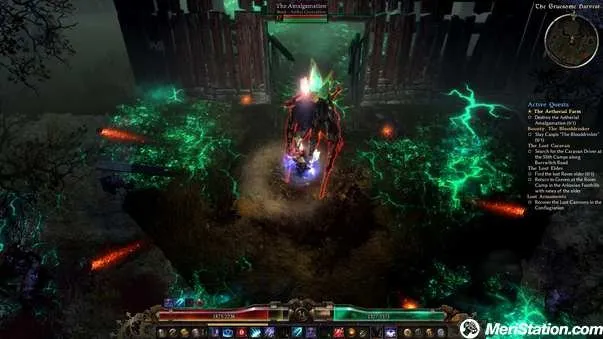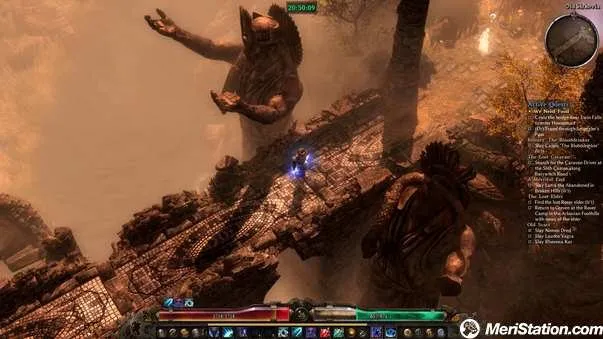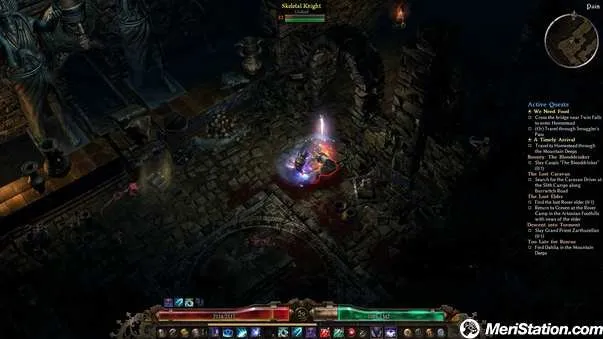Finally, after a long time of development, two crowfunding and years of Early Access, arrives an ARPG made with passion, trade and knowledge, from a part of those responsible for one of the best alternatives to Diablo.
Diablo II left a huge hole to fill in the ARPG field. Not only was it one of the most popular games of its day, it also immersed millions of players in an epic journey of dozens of hours while overcoming the incremental challenges of the game and experiencing the wonders, misfortunes and betrayals of the online game. It was one of those games that marked an era and generated a stream of games trying to follow in its wake, some more original than others, but all falling short in the effort. Among the highlights, six years after the release of the Blizzard game, was Titan Quest, a bet by THQ for a small unknown studio called Iron Lore. At that time, the now defunct producer was trying to become a power beyond their usual licensed games,
Titan Quest was well received despite some problems, but it did not revolutionize the genre at that time. Only later, with the passage of time, improvements, an expansion and much word of mouth, began to consider the importance of the game and what he did. Numerous and substantial reductions put it at a low price in the hands of a new audience, which abandoned by Blizzard (12 years between Diablo 2 and 3), found consolation in a great interpretation of the genre with many own ideas to offer, especially in terms of versatility and personalization of characters. Unfortunately, the studio never had the opportunity to create a planned second part and then die prematurely in 2008 by maneuvers and decisions of the THQ itself.
But a part of the team members decided that what they had created needed continuity, at least as far as fundamentals and philosophy were concerned. With no resources and a few difficult beginnings, they began to consider what would become this Grim Dawn, an ARPG that would serve as a spiritual continuation of Titan Quest, betting on a different environment, with steampunk tints. This announcement was made in 2010, so six years have passed between the announcement and the official launch of the game, a long and arduous journey that could only be completed after two crowdfunding processes, a very transparent development, a lot of patience and a very long process of closed beta that has been key at the time of polishing the game until reaching the current state. The result is an ARPG that clearly achieves its objective,
The story takes us to Cairn, a land where a great empire was formerly located that has been reduced to ashes, invaded by different forces that came out of the mortal plane. The title, Grim Dawn - which could be translated as the "Dark Sunset" - is not free, since the state of desolation of humanity that survives in the game is more than evident. Criminals, monsters, possessed, cultists, undead and other horrors roam at ease for what was once a land of law and order. Our protagonist himself is one of those possessed, one of many humans who has succumbed to the horrors of the Aetherials, caught in a spell and condemned to the gallows. But at the last moment something changes, the possession disappears and our executioner gives us a new opportunity,
As good ARPG, the story is not exactly in the foreground, but Grim Dawn does not leave this element without the necessary attention. Through the dialogues and, especially, the fragments of text that we find in our trip, we find all the necessary information to understand what is happening and why it is happening. From information at the highest level about the forces we are facing and their motives, even small stories about the horrors lived by ordinary people trapped in a nightmare continues. His long time of development has allowed us to take care of a great amount of details like this one, which may seem minor but that help immerse us in fantasy and add value to our experience. It is surprising to arrive at a place separated from the normal "way",*
The setting is an amalgam of elements, not always entirely coherent, where Victorian elements, traditional fantasy, religious elements and a taste for the Lovecraft stories are mixed as we get closer to the final part of the campaign. The mixture turns out to be too diffuse at the end, giving the impression that it is just an excuse to throw a good variety of creatures on the road and to offer things like firearms as one of the combat alternatives for our character. In practice, it is a good way to differentiate the stage and bestiary from more traditional offers, but it does not manage to print that special personality that Titan Quest had because of being so focused on such a rich, concrete and little explored setting, that gave rise to enemies and final bosses with more personality than those of Grim Dawn. All in all, almost any genre aficionado will agree that these are accessory elements of a Hack'n Slash like this.
Going into more relevant, one of the elements that clearly connects Grim Dawn to Titan Quest is the system of classes and character development, looking for that versatility and depth that allows a host of possible configurations and builds as interesting as weird. Faced with games like Diablo 3, which have clearly sought to differentiate themselves from the path started with Diablo 2 based on offering dozens of options, hundreds of possible combinations, the title of Crate embraces that legacy without remorse and takes us back to the time of the trees of skills and incremental additions, with dozens and dozens of points to assign, choosing between the need to add mastery points to reach more advanced skills, or increase the effectiveness and power of the skills we already have. Each new level gives us three points to share, between the two classes (Masteries) that we can unlock for each character. Our class is therefore defined by the combination of those two professions, so that if we choose Soldier and Arcanist (which would be the closest thing to a magician to use), we will have a Battlemage able to stand on the front in the most hard, but can use spells capable of affecting entire areas, freeze enemies or push them out of our area of influence. Of course, within this particular combination, there are many possibilities, being able to choose purer or more mixed interpretations according to our preferences. Our class is therefore defined by the combination of those two professions, so that if we choose Soldier and Arcanist (which would be the closest thing to a magician to use), we will have a Battlemage able to stand on the front in the most hard, but can use spells capable of affecting entire areas, freeze enemies or push them out of our area of influence. Of course, within this particular combination, there are many possibilities, being able to choose purer or more mixed interpretations according to our preferences. Our class is therefore defined by the combination of those two professions, so that if we choose Soldier and Arcanist (which would be the closest thing to a magician to use), we will have a Battlemage able to stand on the front in the most hard, but can use spells capable of affecting entire areas, freeze enemies or push them out of our area of influence. Of course, within this particular combination, there are many possibilities, being able to choose purer or more mixed interpretations according to our preferences. Freeze enemies or push them out of our area of influence. Of course, within this particular combination, there are many possibilities, being able to choose purer or more mixed interpretations according to our preferences. Freeze enemies or push them out of our area of influence. Of course, within this particular combination, there are many possibilities, being able to choose purer or more mixed interpretations according to our preferences.
All the Masteries are compatible with each other, resulting in a total of 15 different classes with two skill trees quite rich in options. One of Grim Dawn's greatest long-term attractions is precisely to create interesting combinations that suit our favorite game mode or that simply seem attractive to us to test its viability. It is also a very generous game in terms of allowing to change our assigned points, since it is quite cheap to do so, so that in a single game we can have enough flexibility, or betting on other configurations once we have accumulated enough levels to try new things . The only downside is that we can not reverse our points assigned to Mastery -which are the ones that determine the degree of depth in each tree-,
There are two other key elements in character progression. We have three general attributes called Physique, Cunning and Spirit that govern an amalgam of basic characteristics of our character. Grosso modo. Physique determines our health bar and our regeneration capacity, Cunning affects our offensive ability in close combat and Spirit affects our ability to cast spells in general, including power and mana base. More open is the Devotion system, which allows us to give the final touch to our character in terms of attributes and abilities. It is a system of constellations in which we can assign points to stars to obtain extra bonuses; depending on the constellations we complete, we can access others, and also get a unique ability once we have all its stars. The rest of the personalization and attributes depends, of course, on the objects with which we are equipping ourselves, as mandated by the canons. Altogether, hundreds of possibilities that increase the replay of a game that already has a more than generous campaign.
Speaking of objects, the game adopts a purely old-school style here, from the classic inventory system with grid to the real piñatas that we are bursting into heroic enemies and bosses, in addition to the tons of scrap that we will find in any group of normal enemy. It is clear that it is traditional and nostalgic, but the truth is that it ends up being a nuisance and it does not surprise us that it has been a facet in which it has tried to innovate in the last times in other ARPG of the style. All in all, Grim Dawn is quite generous with the inventory, offering us a good number of supplementary bags automatically as we go, in addition to the possibility of automatic and unlimited transport through personal portals - except in some special areas. The categories are divided into Magical, Rare, Epic and Legendary, with possibilities of better equipment according to level of difficulty. The vast majority of the objects will be directly to sell, but we will have the possibility to save some for new characters. We can also decompose them using explosives, being able to use some of those components to create new objects in the smithy, although it is not a cheap option.
A key aspect of this kind of titles is replayability. Completing the campaign in normal is a relatively simple challenge, although it will take several dozen hours according to our pace and desire to explore secondary places and missions. It is difficult to create an unviable build in this mode and practically with any combination and updating our equipment without much consideration we should be able to complete the title without major problems. If you prefer a more considerable challenge from the beginning, there is the Veteran option, which will make things more complicated with more enemies and special units. Once the first challenge is over, we will have the doors of Elite and Ultimate open, more suitable for those who always try to create the best characters with which to overcome the most complicated challenges.
A key element in deepening Grim Dawn's mechanics is the types of damage and resistance. In another example of old school design without compromises, the title offers a whopping 10 different types of damage and their respective resistances, as well as additional elements to consider as elusive, blocking, critical and a whole tangle of factors to have in mind and that will excite those who enjoy Theorycrafting. If we also add that Elite and Ultimate will have penalties to resistance, we find a real challenge where we have to ensure that our character is able to work well against all kinds of enemies, performing different types of damage to avoid being sold,
About the production of the game, it is not going to deny that it is a technically outdated title, fruit of a modest development and very long in time, but this also ends up working in its favor. Since the game pursues the essence of the old school, it is also important that graphically and aesthetically remind us of a time away from the colorful and "soft" scenarios of Diablo 3 and Torchlight. The beginning -and we are talking about the first hours- can be done hard in the eyes, with generic scenarios to the maximum, visually devastating caves, towns without any interest and landscapes that we could describe as boring without regard. However, Grim Dawn is one of those titles in which we can clearly identify the effect of the passage of time in its development and the different circumstances of the study. As we complete phases of the game and move to new places, we find how Crate has matured and found a way to get more out of his options, and also how he has incorporated new members thanks to the power of crowdfunding, presenting larger, varied and detailed scenarios, leaving a final flavor quite convincing. On a more personal level, we miss the splendor and visual personality of Titan Quest, but that was a title made in more comfortable circumstances and also, by theme it was impossible for Grim Dawn to resemble him in this section. varied and detailed, leaving a final taste quite convincing. On a more personal level, we miss the splendor and visual personality of Titan Quest, but that was a title made in more comfortable circumstances and also, by theme it was impossible for Grim Dawn to resemble him in this section. varied and detailed, leaving a final taste quite convincing. On a more personal level, we miss the splendor and visual personality of Titan Quest, but that was a title made in more comfortable circumstances and also, by theme it was impossible for Grim Dawn to resemble him in this section.
The attention to detail and the immense nature of the main campaign, with a multitude of secrets and optional zones, also greatly help the game. One of the elements that has attracted our attention is the faction system, which divides allies and enemies into different groups that react to our progression. On the one hand we will have different populations and alliances with which we can ingratiate ourselves in different ways, carrying out missions or eliminating certain classes of enemies, obtaining different degrees of respect that will allow us to access special and specific equipment from them. On the other hand, we will find different groups of enemies, which will accumulate hatred towards us as we defeat more and more members of their ranks, reaching the point that they will begin to deploy more special units against us. Besides that, there is the detail that when we go through the map, we will find antagonistic groups of enemies fighting among themselves; For practical purposes it is not a big deal since they will turn against us once they see us, but it is a great detail that helps us to believe more about the game and its world, the kind of detail that is apparently minor but that speaks a lot about the degree of attention detail and the desire to make a special game.
conclusion
Grim Dawn is a game that starts well and ends better. Completed the first round, we will realize that we have enjoyed a long, dense campaign, full of different types of enemies, with some fantastic encounters and some striking locations, clearly reminding us of the sensations of the Hack'n Slash of yesteryear and complying with honors his goal to be the spiritual successor of Titan Quest that we have searched so much, Once at that point, we can begin to visualize the rest of the game and gloat knowing that the additional difficulty modes offer an authentic and well-measured challenge, which the system of creation and evolution of characters allows us to create totally new and interesting characters to try and that the title hides many secrets that you may not have revealed in a first round.
If we add to that the support for mods and the support of the community -to which we owe things as it is in Spanish thanks to an unofficial translation that we can download in the same menu of the game-, we have a grateful title with your time and money, made with great craft and love for the genre and undoubtedly deserves the attention of any fan of Hack'n Slash worth his salt. For those of us who have followed the game practically since its inception and have attended the adventures and misadventures of Arthur Bruno (design leader of Titan Quest and head of Grim Dawn), it is especially remarkable how such a small team managed to make a game so complete, long and with so much attention to detail. Undoubtedly, one of those games that deserves special attention.
The best
- Great flexibility and versatility to create characters
- A long campaign full of secrets
- Great attention to detail
- Good curve of difficulty, with a lot of travel
- A combat system that works very well
- Good amount and variety of enemies and inventory
- The successor of Titan Quest that we were waiting for
- Excellent quality / price ratio and in Spanish thanks to the community
Worst
- The first hours can become heavy
- The tons and tons of useless scrap that we got to accumulate
- Perhaps a couple of less resistors would have been desirable.
A reference title in its kind, which stands out above its competitors and which you will enjoy from beginning to end, surely several times. A game destined to become classic over the years.
Gameplay 9
Very classic and familiar style, well taken care of from the beginning to be satisfactory and put us in the mentality of liquidating hordes of enemies. Good curve of difficulty and progression, with important challenges as you go up in difficulty modes.
Graphics 7
Grim Dawn is a visually polished game, which will work on virtually any type of computer. The first few hours will be hard visually, with generic scenarios and little grace in general, but will find its tone and rhythm as we go, presenting more variety and allowing more adornments, leaving a good taste in the mouth.
Sound 7
An adequate soundtrack, with melodies suitable for the different moments that accompany the action without shrillness, accompanied by convincing sound effects to enhance the ferocity of the contest.
Multiplayer 7
Being a very small study that has made the game with many difficulties, we will not ask for pears to elm. The game is intended primarily for the solo player, but supports a collaborative mode with a player playing host. Up to three players can share the experience, and they can even fight each other if they activate their PVP.

(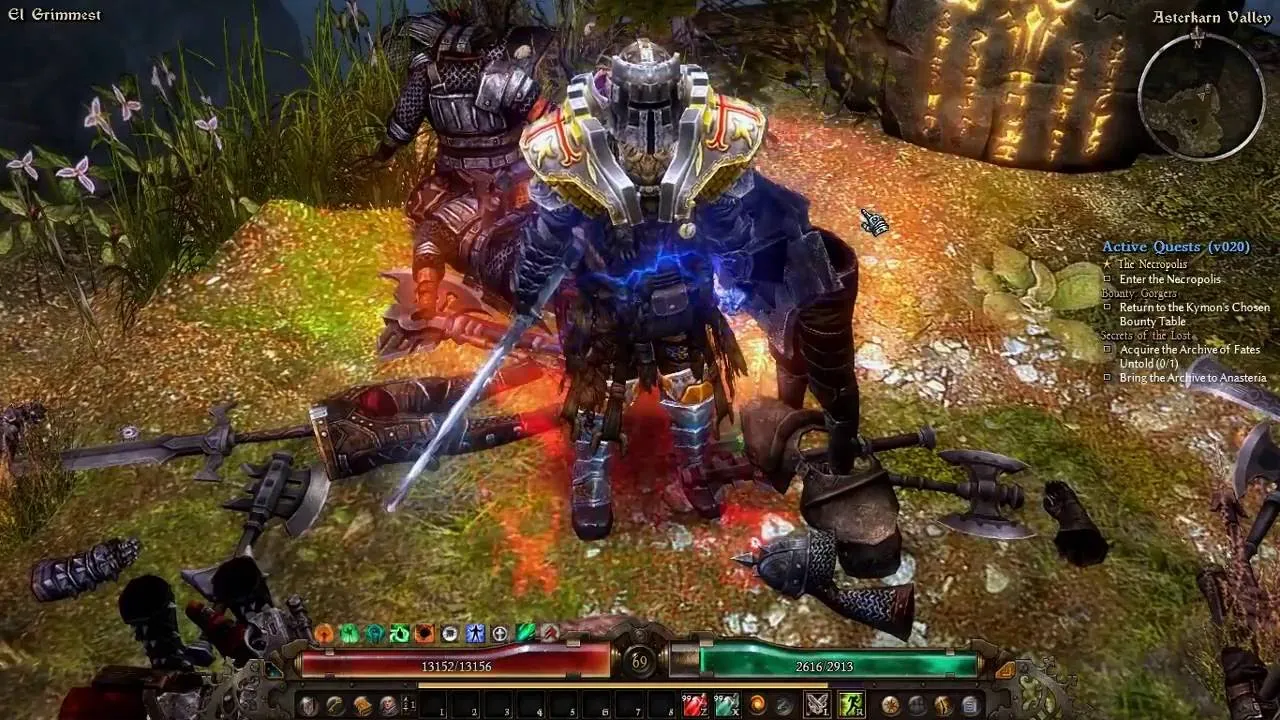 )
)

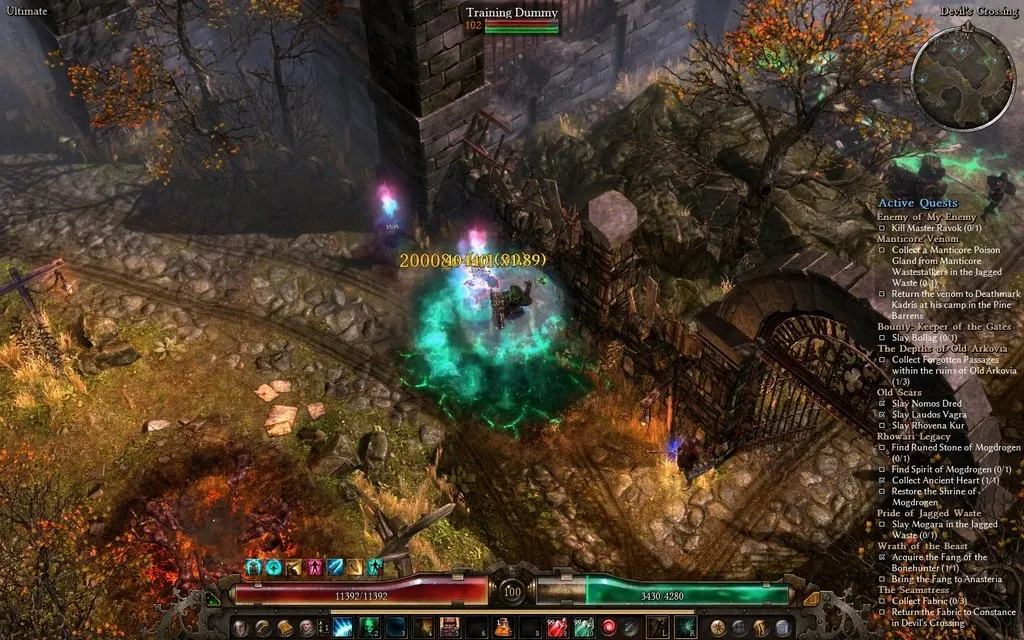
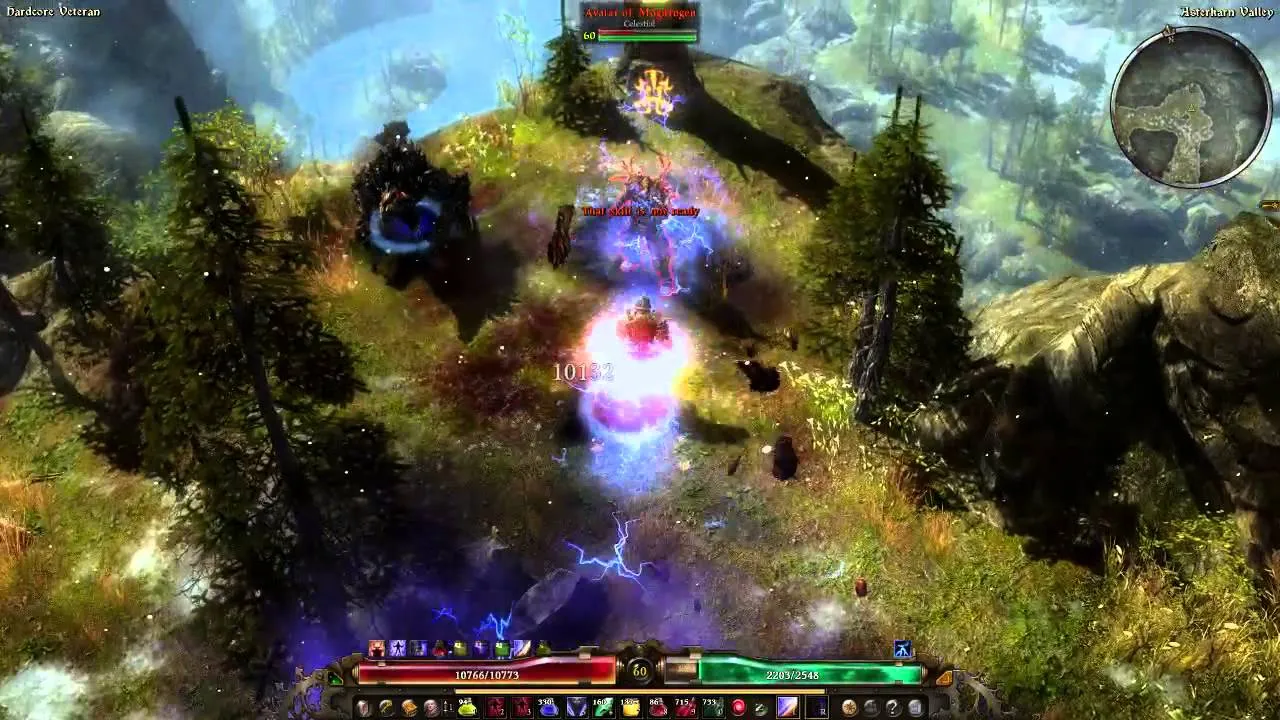


1-6 IMAGECREDIT
THANKS FOR READING, ALSO CHECK OUT MY PREVIOUS REVIEW ON GEARS OF WAR 4 (PC)




